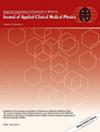The suitability of radiomics extracted from 4DCT motion-compensated reconstruction
Abstract
Purpose
The most appropriate 4DCT image for radiomics analysis remains uncertain, with options including individual respiratory phases and motion-compensated (MC) reconstructions. This study compares radiomic features derived from MC reconstructions and patient-specific, 4D phases, evaluating their influence on feature selection, robustness to registration algorithms and implications for radiomics analysis.
Methods
This study included 223 NSCLC patients. MC reconstructions (MCmean and MCmedian) were generated using three different registration algorithms and compared to a patient-specific optimal 4D phase (TOp), defined as the phase where radiomic feature values exhibited the smallest variability. Ninety-three features, extracted from the tumor region, underwent unsupervised selection to assess how image type influenced feature selection and redundancy. The impact of image type on distant failure prediction was evaluated using bootstrapped univariable Cox regression (p < 0.05) and multivariable modeling. Model performance was assessed across 500 bootstrap resamples, with feature selection frequency, concordance index (CI), and Akaike Information Criterion (AIC) recorded.
Results
Over 60% of selected features differed between 4D phases and MC reconstructions, indicating image type influences feature selection. The proportion of remaining features varied: 11.8% (TOp), 15.1% (MCmean), and 12.9% (MCmedian). The single-phase model, TOp, achieved a CI of 0.72 [0.64–0.77] and an AIC of 267.53, but did not demonstrate clear superiority over MC-based models. Both MCmedian and TOp showed modest improvements over the clinical model, suggesting both image types offer comparable prognostic potential. MC reconstructions were largely robust across registration algorithms, but MCmean and MCmedian reconstructions should not be used interchangeably.
Conclusion
This study highlights differences in radiomic feature selection and predictive performance between MC reconstructions and individual 4DCT phases. MC reconstructions were a viable alternative, demonstrating robustness across registration algorithms. Both approaches can be integrated into radiomics pipelines, but image type selection should be carefully considered.


 求助内容:
求助内容: 应助结果提醒方式:
应助结果提醒方式:


